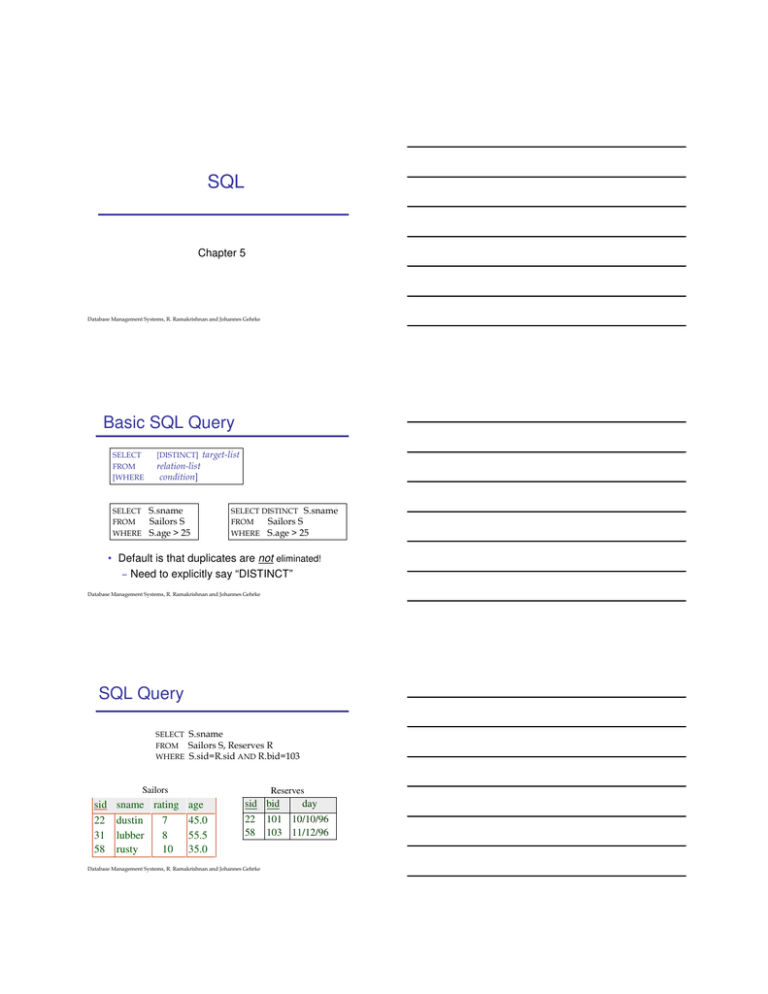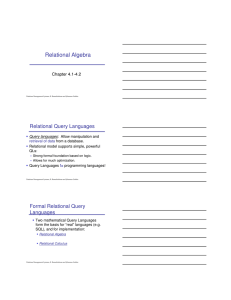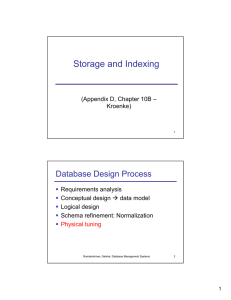SQL Basic SQL Query Chapter 5 not
advertisement

SQL Chapter 5 Database Management Systems, R. Ramakrishnan and Johannes Gehrke Basic SQL Query SELECT FROM [WHERE SELECT FROM WHERE [DISTINCT] target-list relation-list condition] S.sname Sailors S S.age > 25 SELECT DISTINCT S.sname FROM Sailors S WHERE S.age > 25 • Default is that duplicates are not eliminated! – Need to explicitly say “DISTINCT” Database Management Systems, R. Ramakrishnan and Johannes Gehrke SQL Query SELECT FROM WHERE S.sname Sailors S, Reserves R S.sid=R.sid AND R.bid=103 Sailors sid 22 31 58 sname rating age dustin 7 45.0 lubber 8 55.5 rusty 10 35.0 Reserves sid bid day 22 101 10/10/96 58 103 11/12/96 Database Management Systems, R. Ramakrishnan and Johannes Gehrke Conceptual Evaluation Strategy SELECT FROM [WHERE [DISTINCT] target-list relation-list condition] Database Management Systems, R. Ramakrishnan and Johannes Gehrke Example of Conceptual Evaluation SELECT FROM WHERE S.sname Sailors S, Reserves R S.sid=R.sid AND R.bid=103 (sid) sname rating age (sid) bid day 22 dustin 7 45.0 22 22 dustin 7 45.0 58 101 10/10/96 103 11/12/96 31 lubber 8 55.5 22 101 10/10/96 31 lubber 8 55.5 58 103 11/12/96 58 rusty 10 35.0 22 101 10/10/96 58 rusty 10 35.0 58 103 11/12/96 Database Management Systems, R. Ramakrishnan and Johannes Gehrke A Slightly Modified Query SELECT S.sid FROM Sailors S, Reserves R WHERE S.sid=R.sid AND R.bid=103 • Would adding DISTINCT to this query make a difference? Database Management Systems, R. Ramakrishnan and Johannes Gehrke ICE: Find sid’s of sailors who’ve reserved a red or a green boat Database Management Systems, R. Ramakrishnan and Johannes Gehrke ICE: What Does This Query Compute? SELECT S.sid FROM Sailors S, Boats B1, Reserves R1, Boats B2, Reserves R2 WHERE S.sid=R1.sid AND R1.bid=B1.bid AND S.sid=R2.sid AND R2.bid=B2.bid AND B1.color=‘red’ AND B2.color=‘green’ Database Management Systems, R. Ramakrishnan and Johannes Gehrke ICE: Find sid’s of sailors who’ve reserved a red and a green boat Database Management Systems, R. Ramakrishnan and Johannes Gehrke Expressions and Strings SELECT FROM WHERE S.age, S.age-5 AS age1, 2*S.age AS age2 Sailors S S.sname LIKE ‘B_%B’ • AS is used to name fields in result. • LIKE is used for string matching `_’ stands for any one character `%’ stands for 0 or more arbitrary characters. Database Management Systems, R. Ramakrishnan and Johannes Gehrke Nested Queries (with Correlation) Find names of sailors who have reserved boat #103: SELECT S.sname FROM Sailors S WHERE EXISTS (SELECT * FROM Reserves R WHERE R.bid=103 AND S.sid=R.sid) Database Management Systems, R. Ramakrishnan and Johannes Gehrke Nested Queries (with Correlation) Find names of sailors who have not reserved boat #103: SELECT S.sname FROM Sailors S WHERE NOT EXISTS (SELECT * FROM Reserves R WHERE R.bid=103 AND S.sid=R.sid) Database Management Systems, R. Ramakrishnan and Johannes Gehrke Division in SQL Find sailors who’ve reserved all boats SELECT S.sname FROM Sailors S WHERE NOT EXISTS ((SELECT B.bid FROM Boats B) EXCEPT (SELECT R.bid FROM Reserves R WHERE R.sid=S.sid)) Database Management Systems, R. Ramakrishnan and Johannes Gehrke Division in SQL (without Except!) Find sailors who’ve reserved all boats. SELECT S.sname FROM Sailors S WHERE NOT EXISTS (SELECT B.bid FROM Boats B WHERE NOT EXISTS (SELECT R.bid Sailors S such that ... FROM Reserves R WHERE R.bid=B.bid there is no boat B without ... AND R.sid=S.sid)) a Reserves tuple showing S reserved B Database Management Systems, R. Ramakrishnan and Johannes Gehrke More on Set-Comparison Operators op ANY, op ALL op can be >, <, =, >=, <=, <> Find sailors whose rating is greater than that of all sailors called Horatio: Database Management Systems, R. Ramakrishnan and Johannes Gehrke Aggregate Operators Significant extension of relational algebra. COUNT (*) COUNT ( [DISTINCT] A) SUM ( [DISTINCT] A) AVG ( [DISTINCT] A) MAX (A) MIN (A) single column SELECT COUNT (*) FROM Sailors S SELECT AVG (S.age) FROM Sailors S WHERE S.rating=10 SELECT COUNT (DISTINCT FROM Sailors S WHERE S.sname=‘Bob’ S.rating) Database Management Systems, R. Ramakrishnan and Johannes Gehrke ICE: Find name and age of the oldest sailor(s) with rating > 7 Database Management Systems, R. Ramakrishnan and Johannes Gehrke Aggregate Operators So far, we’ve applied aggregate operators to all (qualifying) tuples Sometimes, we want to apply them to each of several groups of tuples. Consider: Find the age of the youngest sailor for each rating level. If rating values go from 1 to 10; we can write 10 queries that look like this: SELECT MIN (S.age) For i = 1, 2, ... , 10: FROM Sailors S WHERE S.rating = i Database Management Systems, R. Ramakrishnan and Johannes Gehrke GROUP BY SELECT [DISTINCT] target-list FROM relation-list [WHERE condition] GROUP BY grouping-list Find the age of the youngest sailor for each rating level SELECT FROM GROUP BY S.rating, MIN(S.Age) Sailors S S.rating Database Management Systems, R. Ramakrishnan and Johannes Gehrke Conceptual Evaluation Strategy SELECT [DISTINCT] target-list FROM relation-list [WHERE condition] GROUP BY grouping-list • Semantics of an SQL query defined as follows: Database Management Systems, R. Ramakrishnan and Johannes Gehrke Find the age of the youngest sailor with age >= 18, for each rating with at least one such sailor SELECT S.rating, MIN FROM Sailors S WHERE S.age >= 18 GROUP BY S.rating sid 29 22 64 58 (S.age) sname rating age brutus 1 33.0 dustin 7 45.0 horatio 7 35.0 rusty 10 35.0 sid 22 31 71 64 29 58 sname rating dustin 7 lubber 8 zorba 10 horatio 7 brutus 1 rusty 10 rating 1 33.0 7 35.0 10 35.0 Database Management Systems, R. Ramakrishnan and Johannes Gehrke age 45.0 15.5 16.0 35.0 33.0 35.0 Answer relation ICE: What does this query compute? SELECT B.bid, COUNT (*) AS scount FROM Reserves R, Boats B WHERE R.bid=B.bid AND B.color=‘red’ GROUP BY B.bid Database Management Systems, R. Ramakrishnan and Johannes Gehrke ICE: Find those ratings for which the average age is the minimum over all ratings Database Management Systems, R. Ramakrishnan and Johannes Gehrke ICE: What does this query compute? SELECT Temp.rating, Temp.minage FROM (SELECT S.rating, MIN (S.age) AS FROM Sailors S WHERE S.age >= 18 GROUP BY S.rating) AS Temp WHERE Temp.cnt >= 2 minage, COUNT(*) AS cnt Database Management Systems, R. Ramakrishnan and Johannes Gehrke Queries With GROUP BY and HAVING SELECT [DISTINCT] target-list FROM relation-list [WHERE qualification] GROUP BY grouping-list HAVING group-qualification Find the age of the youngest sailor with age >= 18 for each rating level with at least 2 such sailors SELECT S.rating, MIN(S.Age) FROM Sailors S WHERE S.age >= 18 GROUP BY S.rating HAVING COUNT(*) >= 2 Database Management Systems, R. Ramakrishnan and Johannes Gehrke Conceptual Evaluation Strategy • Semantics of an SQL query defined as follows: Compute the cross-product of relation-list Discard resulting tuples if they fail condition. Delete attributes that are not in target-list Remaining tuples are partitioned into groups by the value of the attributes in grouping-list The group-qualification is applied to eliminate some groups One answer tuple is generated per qualifying group • Note: Does not imply query will actually be evaluated this way! Database Management Systems, R. Ramakrishnan and Johannes Gehrke Find the age of the youngest sailor with age >= 18, for each rating with at least 2 such sailors SELECT S.rating, MIN (S.age) FROM Sailors S WHERE S.age >= 18 GROUP BY S.rating HAVING COUNT (*) > 1 sid 22 31 71 64 29 58 rating 1 7 7 8 10 sname rating age dustin 7 45.0 lubber 8 55.5 zorba 10 16.0 horatio 7 35.0 brutus 1 33.0 rusty 10 35.0 age 33.0 45.0 35.0 55.5 35.0 Database Management Systems, R. Ramakrishnan and Johannes Gehrke rating 7 35.0 Answer relation ICE: Find the age of the youngest sailor with age >= 18, for each rating with at least 2 sailors (of any age) Database Management Systems, R. Ramakrishnan and Johannes Gehrke Find the average age for each rating, and order results in ascending order on avg. age SELECT S.rating, AVG FROM Sailors S GROUP BY S.rating ORDER BY avgage (S.age) AS avgage Database Management Systems, R. Ramakrishnan and Johannes Gehrke Null Values • Field values in a tuple are sometimes unknown e.g., a rating has not been assigned • Field values are sometimes inapplicable e.g., no spouse’s name • SQL provides a special value null for such situations. Database Management Systems, R. Ramakrishnan and Johannes Gehrke Queries and Null Values SELECT FROM WHERE S.Name Sailors S S.Age > 25 • What if S.Age is NULL? Database Management Systems, R. Ramakrishnan and Johannes Gehrke Three-valued Logic SELECT FROM WHERE S.Name Sailors S NOT(S.Age > 25) OR S.rating > 7 • What if one or both of S.age and S.rating are NULL? NOT Truth Table A NOT(A) True False NULL OR Truth Table A/B True False NULL True False Database Management Systems, R. Ramakrishnan and Johannes Gehrke General Constraints Reserves ( sname CHAR(10) NOT NULL, bid INTEGER NOT NULL, day DATE NOT NULL, PRIMARY KEY (bid,day), CONSTRAINT noInterlakeRes CHECK (`Interlake’ <> ( SELECT B.bname FROM Boats B WHERE B.bid=bid))) CREATE TABLE Database Management Systems, R. Ramakrishnan and Johannes Gehrke NULL Constraints Over Multiple Relations Number of boats plus number of sailors is < 100 CREATE ASSERTION smallClub CHECK ( (SELECT COUNT (S.sid) FROM Sailors S) + (SELECT COUNT (B.bid) FROM Boats B) Database Management Systems, R. Ramakrishnan and Johannes Gehrke < 100 )







